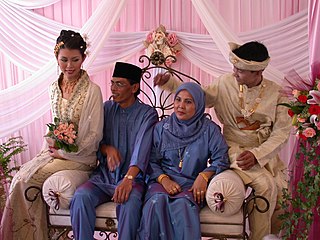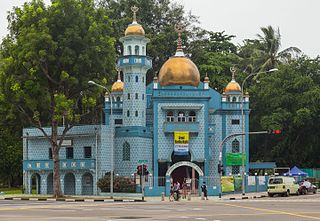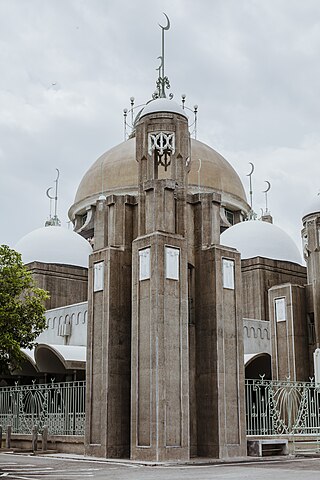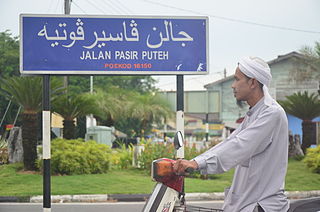
Tengku Ampuan Tua Tengku Intan Zaharah binti Almarhum Tengku Seri Setia Raja Tengku Hitam Omar was the Tengku Ampuan Tua of Terengganu. She was formerly the Tengku Ampuan Besar of Terengganu from 1945 to 1979, the Tengku Ampuan of Terengganu from 1979 to 1998 and Tengku Ampuan Tua of Terengganu from 1998 until her death in 2015. She also served as the fourth Raja Permaisuri Agong of Malaysia from 1965 to 1970.

Malay Singaporeans are Singaporeans of Malay ancestry, including those from the Malay Archipelago. They constitute approximately 13.5% of the country's residents, making them the second largest ethnic group in Singapore. Under the Constitution of Singapore, they are recognised by the government as the indigenous people of the country, with Malay as the national language of Singapore.

Masjid Malabar or Malabar Muslim Jama-Ath Mosque, also known as Golden Dome Mosque; is Singapore's only Malabar Muslim mosque. The mosque is located at the junction of Victoria Street and Jalan Sultan in the Kampong Glam district, in the Rochor Planning Area within the Central Area. The mosque is built on the Sultan Mosque style with traditional blue and white lapis lazuli tile facade. The mosque was nicknamed as little cousin of the Sultan Mosque, because of similar golden domes.
Sultan Idris Al-Mutawakil Alallahi Shah Ibni Almarhum Sultan Iskandar Shah Kaddasullah, CMG was the 33rd Sultan of Perak reigning from 5 January 1963 until his death on 31 January 1984. He was the son of Sultan Iskandar Shah.

Sultan Sulaiman Royal Mosque is Selangor's royal mosque, which is located in Klang, Selangor, Malaysia. It was constructed by the British in the early 1932 and was officially opened in 1933 by the late Almarhum Sultan Sir Alaeddin Sulaiman Shah.

The Al-Muktafi Billah Shah Mosque is the modern royal mosque of Terengganu, Malaysia. It is located at Kampung Ladang, Kuala Terengganu. Construction of the mosque began in 1981 and the mosque was completed in 1984. The mosque was officially opened in September 1984 by the late Sultan of Terengganu Almarhum Sultan Mahmud Al-Muktafi Billah Shah. The new Royal Mausoleum is a short distance from the mosque.

The Abidin Mosque is Terengganu's old state royal mosque built by Sultan Zainal Abidin II between 1793 and 1808. The mosque, which is also known as the White Mosque or the Big Mosque, is located in Kuala Terengganu, Terengganu, Malaysia. The old Royal Mausoleum is situated near the mosque.

This article lists important figures and events in Malaysian public affairs during the year 1967, together with births and deaths of notable Malaysians.

Bidadari Cemetery is a defunct cemetery in Singapore. It used to serve the Christian, Muslim, Hindu and Sinhalese communities, and accepted burials between 1907 and 1972. The site of Bidadari Cemetery used to be Istana Bidadari, the home of Che Puan Besar Zubaidah, who was the second wife of Sultan Abu Bakar of Johor Istana.

Sultan of Terengganu is the title of the constitutional head of Terengganu state in Malaysia. The current sultan, Mizan Zainal Abidin of Terengganu, is the 18th sultan and 13th Yang di-Pertuan Agong of Malaysia from 2006 to 2011. He is the head of Islam in the state and the source of all titles, honours and dignities in the state.

The Abu Bakar Royal Mosque is a royal mosque located in Pekan, Pahang, Malaysia. It was officially opened in 1976 by Sultan Ahmad Shah of Pahang replacing the nearby Abdullah Mosque or Old Royal Mosque. Its interesting features include the royal mausoleum.
Kedah Royal Mausoleum or Langgar Royal Mausoleum is a Kedah royal burial grounds. It is located in Langgar, Kota Setar District, Kedah, Malaysia.

The Jalan Ampang Muslim Cemetery is a cemetery at the Kuala Lumpur city centre, Malaysia. It is located at Jalan Ampang near Kuala Lumpur City Centre. The cemetery was established on 1819.

The Mahmoodiah Royal Mausoleum is a Royal Mausoleum of Johor located at Bukit Mahmoodiah in Jalan Mahmoodiah, Johor Bahru, Malaysia. The first Sultan of Johor buried here was Sultan Abu Bakar in 1895. Besides that, the founder of UMNO, Dato' Onn Jaafar was buried next to his father, Dato Jaafar bin Muhammad's grave.
Pahang Old Royal Mausoleum is a Pahang royal burial grounds at Kampung Marhum, Kuala Pahang, Pekan, Pahang, Malaysia.

Kelantan Royal Mausoleum or Langgar Royal Mausoleum is a Kelantan royal burial ground located at Kampung Langgar near Kota Bharu, Kelantan, Malaysia.

The Al-Ghufran Royal Mausoleum is a Royal Mausoleum of Perak located near Ubudiah Mosque at Bukit Chandan in Jalan Istana, Kuala Kangsar, Malaysia. The first Sultan of Perak buried here was Sultan Idris Murshidul Azzam Shah I in 1916.
The Esteemed Order of the Crown of Pahang is a knighthood order of the Sultanate of Pahang.
In Singapore, there are numerous cemeteries that house Muslim graves. Many of them are not in use currently as most of the burials take place at Pusara Aman in Choa Chu Kang. This is a non-exhaustive list of the Muslim cemeteries that have been demolished such as Bidadari Cemetery, as well as cemeteries that have not been in use for years. Included in this list are Keramats (Mausoleums) that are present in Singapore.

Ambo Sooloh (1891–1963) was a Singaporean businessman and philanthropist. Born in Singapore to a wealthy mercantile family, Sooloh was one of the founders of the Malay-language newspaper Utusan Melayu. He also served as the chairman of the Singapore Malay Union from 1934 to 1937.
















